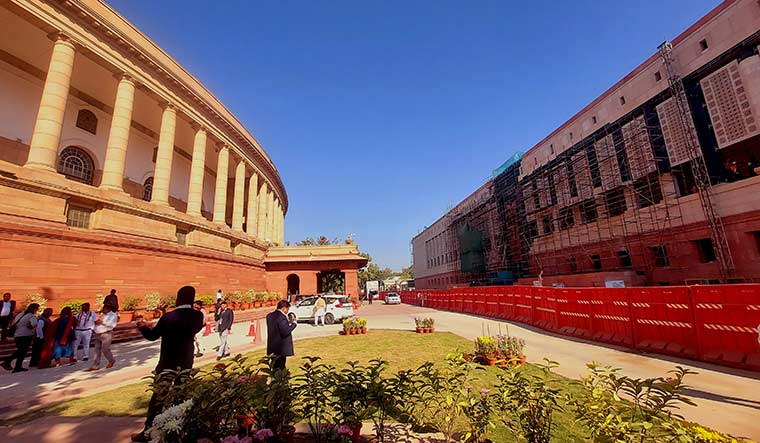At the heart of New Delhi, a resplendent circular structure stands proudly, embodying the very essence of Indian democracy—the Parliament House. This awe-inspiring architectural marvel, set to take its place in the annals of history as Prime Minister Narendra Modi inaugurates the new complex, has been a constant presence in the country’s political landscape for almost a century. Known as Sansad Bhavan in Hindi, India’s Parliament building has served as a symbol of unity, strength, and the collective will of its people for decades.
Designed by the esteemed British architects Sir Herbert Becker and Sir Edwin Lutyens, the existing Parliament building took shape in the early 20th century. Its foundation stone, laid in 1921 by Britain’s Duke of Connaught, stands as a testament to the building’s enduring legacy. After six years of meticulous construction, the Parliament House was inaugurated in 1927, marking a significant milestone in India’s relentless pursuit of self-governance.
The Parliament House serves as a visual testament to India’s democratic principles, seamlessly blending Indian and Western architectural styles. Its expansive circular structure boasts an impressive colonnaded exterior adorned with 144 majestic pillars. Rising above it all, the central dome stands as a beacon of grandeur, graced by the national emblem of India—a remarkable portrayal of four Asiatic lions, each facing a cardinal direction, symbolizing strength, courage, and power.
Monumental Parliament Building: Illuminating Beacon of Democracy and Witness to India’s Illustrious Journey
Within its walls, the Parliament House houses two chambers—the Lok Sabha (House of the People or Lower House) and the Rajya Sabha (Council of States or Upper House)—where elected representatives from all corners of India gather to deliberate, discuss, and legislate. The Lok Sabha, representing the people’s voice, occupies the larger chamber, while the Rajya Sabha, representing the states and union territories, finds its place in the smaller chamber.
The Lok Sabha chamber exudes vibrancy with its verdant green upholstery, accommodating over 550 seats for Members of Parliament (MPs). At the forefront of the chamber, the Speaker’s chair, adorned with the national emblem, presides over the proceedings, lending a sense of authority. In contrast, the Rajya Sabha chamber embraces rich shades of red, providing seating for 250 Rajya Sabha members. In the center of the chamber, a circular table known as the “Well” serves as the focal point for discussions and deliberations.
Yet, the significance of India’s Parliament building extends far beyond its architectural splendor. It stands as an enduring testament to the country’s democratic ethos, where the people elect their representatives to shape the nation’s destiny. Within its hallowed halls, history has unfolded, and laws have been enacted, shaping the lives of millions.
The Parliament House has borne witness to numerous defining moments in India’s journey. It stood witness to the momentous occasion when the Indian Constitution was adopted on January 26, 1950, signifying India’s transformation into a republic. Within its chambers, impassioned debates on critical issues have unfolded, laws have been framed, and ideas have been exchanged, propelling India’s progress.
The resounding speeches of eminent leaders have echoed through its corridors—the profound words of first Prime Minister Jawaharlal Nehru, the calm determination of Lal Bahadur Shastri, the eloquence of Indira Gandhi, and the poetic brilliance of Atal Bihari Vajpayee—all of whom have left an indelible mark on the nation’s path.
Shining Symbol of Democracy and Testament to India’s Glorious Journey
On the eve of Independence, as the Constituent Assembly convened at 11:00 pm, President Rajendra Prasad presided over the historic gathering. Sucheta Kriplani, a member from Uttar Pradesh
Standing proudly at the core of New Delhi, a magnificent circular structure serves as a testament to the very essence of Indian democracy—the Parliament House. This remarkable architectural marvel, poised to etch its mark in the annals of history, is set to be inaugurated by Prime Minister Narendra Modi. For nearly a century, it has remained an unwavering presence within the country’s political landscape. Known as Sansad Bhavan in Hindi, India’s Parliament building has stood as a symbol of unity, resilience, and the collective will of its people throughout the ages.
Crafted by esteemed British architects Sir Herbert Becker and Sir Edwin Lutyens, the existing Parliament building came into being during the early 20th century. Its foundation stone, laid in 1921 by Britain’s Duke of Connaught, stands as a testament to the enduring legacy of this iconic structure. After six years of meticulous construction, the Parliament House was inaugurated in 1927, marking a momentous milestone in India’s relentless pursuit of self-governance.

